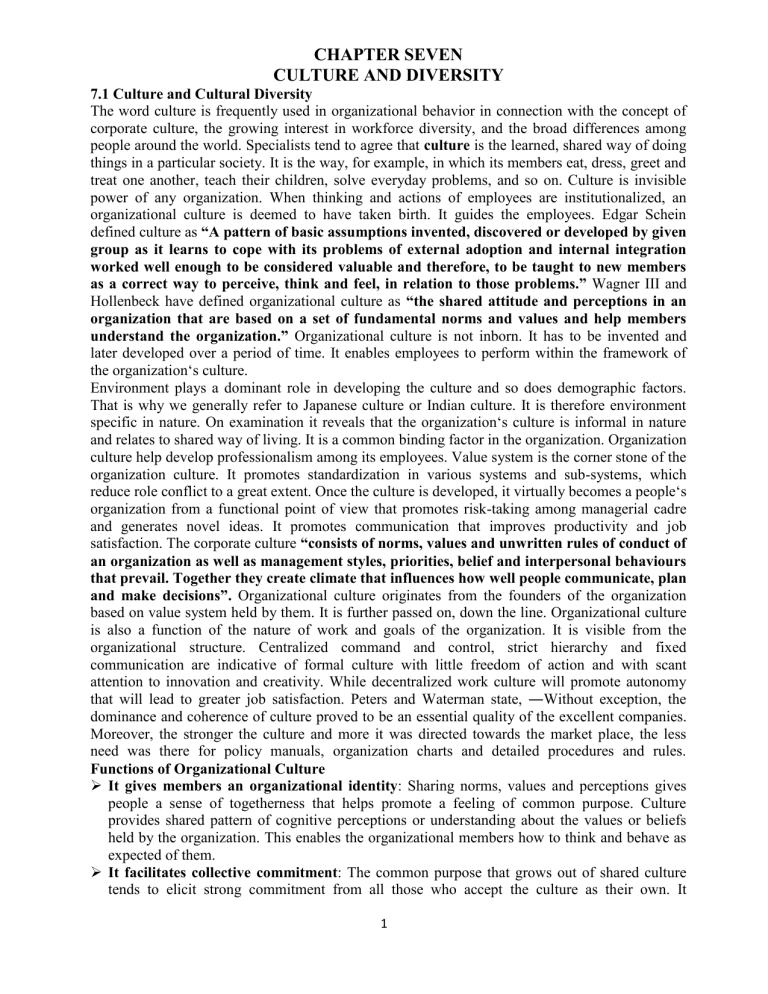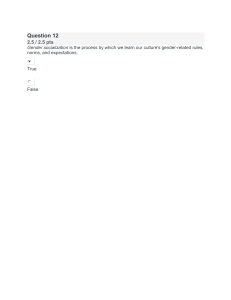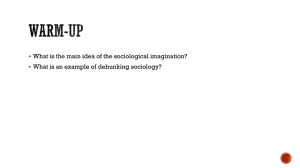
CHAPTER SEVEN CULTURE AND DIVERSITY 7.1 Culture and Cultural Diversity The word culture is frequently used in organizational behavior in connection with the concept of corporate culture, the growing interest in workforce diversity, and the broad differences among people around the world. Specialists tend to agree that culture is the learned, shared way of doing things in a particular society. It is the way, for example, in which its members eat, dress, greet and treat one another, teach their children, solve everyday problems, and so on. Culture is invisible power of any organization. When thinking and actions of employees are institutionalized, an organizational culture is deemed to have taken birth. It guides the employees. Edgar Schein defined culture as “A pattern of basic assumptions invented, discovered or developed by given group as it learns to cope with its problems of external adoption and internal integration worked well enough to be considered valuable and therefore, to be taught to new members as a correct way to perceive, think and feel, in relation to those problems.” Wagner III and Hollenbeck have defined organizational culture as “the shared attitude and perceptions in an organization that are based on a set of fundamental norms and values and help members understand the organization.” Organizational culture is not inborn. It has to be invented and later developed over a period of time. It enables employees to perform within the framework of the organization‘s culture. Environment plays a dominant role in developing the culture and so does demographic factors. That is why we generally refer to Japanese culture or Indian culture. It is therefore environment specific in nature. On examination it reveals that the organization‘s culture is informal in nature and relates to shared way of living. It is a common binding factor in the organization. Organization culture help develop professionalism among its employees. Value system is the corner stone of the organization culture. It promotes standardization in various systems and sub-systems, which reduce role conflict to a great extent. Once the culture is developed, it virtually becomes a people‘s organization from a functional point of view that promotes risk-taking among managerial cadre and generates novel ideas. It promotes communication that improves productivity and job satisfaction. The corporate culture “consists of norms, values and unwritten rules of conduct of an organization as well as management styles, priorities, belief and interpersonal behaviours that prevail. Together they create climate that influences how well people communicate, plan and make decisions”. Organizational culture originates from the founders of the organization based on value system held by them. It is further passed on, down the line. Organizational culture is also a function of the nature of work and goals of the organization. It is visible from the organizational structure. Centralized command and control, strict hierarchy and fixed communication are indicative of formal culture with little freedom of action and with scant attention to innovation and creativity. While decentralized work culture will promote autonomy that will lead to greater job satisfaction. Peters and Waterman state, ―Without exception, the dominance and coherence of culture proved to be an essential quality of the excellent companies. Moreover, the stronger the culture and more it was directed towards the market place, the less need was there for policy manuals, organization charts and detailed procedures and rules. Functions of Organizational Culture It gives members an organizational identity: Sharing norms, values and perceptions gives people a sense of togetherness that helps promote a feeling of common purpose. Culture provides shared pattern of cognitive perceptions or understanding about the values or beliefs held by the organization. This enables the organizational members how to think and behave as expected of them. It facilitates collective commitment: The common purpose that grows out of shared culture tends to elicit strong commitment from all those who accept the culture as their own. It 1 provides shared – pattern of feelings to the organizational members to make them know what they are expected to value and feel. It promotes systems stability: By encouraging a shared sense of identity and commitment, culture encourages lasting integration and cooperation among the members of an organization. It enhances social stability by holding the organizational members together by providing them appropriate standards for which the members should stand for. It shapes behaviour by helping members make sense of their surroundings: An organization culture serves as a source of shared meaning that explains why things occur the way they do. Organizational culture is not fully visible but felt. At less visible level culture reflects the value shared by organizational members. It provides a boundary: Culture creates distinction between one organization and the other. Such boundary – defining helps identify members and non-members of the organization. Culture facilitates the generation of commitment to something larger than one‘s individual selfinterest. It serves as a control mechanism that guides and shapes the attitude and behaviour of organizational members. It helps organizational members stick to conformity and expected mode of behaviour: Culture ensures that everyone thinks and behaves in a prescribed manner. Managing Organizational Culture Once the culture is formed, it is the duty of the organization to enrich it. Management of organizational culture is explained below in the figure. Top Management Philosophy of Organization’s founders Organizational Culture Selection Criteria Socialization 1. Philosophy of Organization’s Founders: Culture is valuable for the organization because it enhances organizational commitment. It guides employees towards right direction. Culture is also marked by dysfunctional aspect as well when shared values conflict with the aspects of organizational effectiveness. Such situations take place in dynamic organizational environment where organizations do not change with changed environmental factors. Early traditions are the basis of culture in the organization. The vision of founders and various functions of the organization create culture. The ideology and customs are bedrock of any organizational culture. The mission and vision of founder members, hard work, competitive spirit and the way of life is important as it establishes cultural value of any organization. The vision of Ratanji Tata has created a Tata culture. Luthans has suggested following two steps in creation of culture. 1) A single person (founder) has an idea for a new enterprise. 2) The founder brings in one or more other key people and creates a core group that shares a common vision with the founder. That is, all in the core group believe that the idea is good one, is workable, and is worth running some risk for. 2 2. Selection Process The explicit goal of the selection process is to identify and hire individuals who have the knowledge, skills, and abilities to perform the jobs within the organization successfully. As more than one candidate is found suitable, the organization selects that candidate which it thinks will fit well into the organization. This attempt of proper matching results in hiring those people whose values are essentially consistent with those of the organization or at least a significant part of those values. Additionally, the selection process provides information to applicants about the organization. Applicants learn about the organization, and, if they find that their values and the organization’s values do not match or fit, they can withdraw from the selection process. Selection, therefore, is a two-way street allowing either the organization or the applicant to abrogate a relationship if there is a mismatch. In this way, the selection process sustains an Organizational Culture by selecting out those individuals who might attack or undermine its core values. 3. Actions of Top Management The actions of top management also have a major impact on the Organizational Culture. Through what they say and how they behave, senior executives establish norms that filter down through the organization as to whether risk-taking is desirable; how much freedom managers should give their subordinates, what is appropriate dress; what actions will pay off in terms of pay raises, promotions, and other rewards; and the like. 4. Socialization Even though the new employees have been selected on the basis of their values matching with that of organization’s values, they are not fully indoctrinated in the Organizational Culture. Maybe most important, because they are unfamiliar with the Organizational Culture, new employees are potentially likely to disturb the Beliefs and Customs that are in place. The organization will, therefore, want to help new employees to adapt its culture. The process that adapts employees to the Organizational Culture is socialization. Socialization as a process is made up of three stages. Pre arrival – the first stage covers all the learning that occurs before a new member joins the organisation. Encounter – in this stage, the new employee sees what the organization is really like and confronts the possibility that expectations and reality differ. Metamorphis - in this final stage, the relatively long-lasting changes take place. This three-stage process impacts on new employees work productivity, commitment to organization’s goals, and eventual decision to stay with the organization. LEVELS OF CULTURE According to Edgar Schein, there are three levels of culture; these are discussed in the succeeding paragraphs. 1) Observable artifacts of culture: These are the symbols of culture in the physical and social work environment. These are visible and most accessible. They include organizational heroes. As mentioned earlier, organizational culture originates from the top management and their leadership styles. These leaders become the role model. Employees would like to copy their behaviour, work ethics and represent what an organization stands for. Modeled 3 behaviour is a powerful tool and organization should continuously learn. They should reenforce organizational value system. Rites and rituals are recurring activities that are used at special times to influence the behaviour and understanding of organizational members. For example taking out Colors when oath ceremony is underway in the defense services. Colors remind soldiers of the excellent work done by their predecessors and the sacrifices they have made. Presentations of certificates and convocation ceremony in the university. Rituals are systems of rites like departmental song, colors, and company picnic or retirement dinners. Cultural symbols are an object, act, or event that serves to transmit cultural meaning. Corporate uniform, tie, buttons etc are the examples. Saga is a heroic account of accomplishments. Sagas are important because they are being used to tell new members the real mission of the organization, how the organization operates, and how individual can fit into the organizational settings. A saga of valor and sacrifices in the regimental history is a good example of organizational culture. It communicates organizational culture. 2) Shared values: there are two types of values, i.e. terminal values that reflect end state of existence and instrumental values. Instrumental values are means to achieve terminal values. Being hard working (instrumental value) may lead to achieve solace (Terminal value). Shared value resides at the very heart of the organizational culture. It helps turn routine activities into valuable, important actions, tie the corporation to important value of society that may provide a very distinctive source of competitive advantage. Employees should be taken into confidence and good work done by them should be recognized so that other workers are motivated to work harder for the organization. Values should be linked with work. A person should feel that he is producing an umbrella that keeps health of the society. He is not merely working for material gain but for good of society. Organizations should therefore develop a “dominant and coherent set of shared values” so that individual behaves in a graduated manner in line with the organizational philosophy. 3) Common Assumptions: Common assumptions are fallout of shared value system and observable artifacts of culture. Employees, over a period of time form within themselves a common culture. In Bajaj Automobiles, everybody comes in time to the plant. Punctuality is therefore a common assumption that is embedded in their organizational culture. In Maruti Udhog, safety is accorded a high priority. Workers health and safety in plant therefore is assumed a common assumption. The cultural artifacts develop cohesiveness that leads to operational productivity. If society believes in truth and non-violence. Therefore it is a common assumption of that societal culture. Myths: Unproven and often unstated beliefs that are accepted by employees. For example: Safe plant is an efficient plant. Safety over rides every other process in nuclear power plant. In spite of that there are plants where accidents have taken place. Therefore safety is a myth. Sub-culture: There is typical and unique dominant culture within each organization. There is usually a sub-culture within a particular group or department with its own pattern of values and philosophy that is not inconsistent with the values of the larger culture of the organization itself. In an organization, finance department may have its own sub-culture that may be part of larger culture of the organization. It is typical of R and D departments to have its own sub-culture in which every individual enjoys a comparatively greater freedom of action. These sub-cultures co-exist with and enhance the overall organizational culture. This is especially true in functionally structured organizations. Counter Culture: Countercultures have a pattern of values and beliefs that sharply contracts the dominant social norms, values and behaviour patterns. This counterculture tends to emerge when individuals or group strongly feel that the existing organizational culture is too rigid and does not support their creativity or the style of operation. Countercultures are 4 distinctly visible in the organizations that have been merged or acquisitioned. In relation to dominant organizational culture, the counterculture groups usually engage in three types of dissent. 1. Direct opposition to organization‘s dominant values. 2. Opposition to the dominant culture‘s power base. 3. Oppositions to the methods of interaction with dominate culture. 7.2 Globalization and People at Work OB scholars are increasingly sensitive to the need to better understand how management and organizational practices vary among the world‘s cultures. In this sense, we must be familiar with the importance of multinational employers, the diversity of multicultural workforces, and the special demands of international work assignments. A true multinational corporation, or MNC, is a business firm that has extensive international operations in more than one foreign country. MNCs are more than just companies that do business abroad; they are global concerns exemplified by Ford, Royal-Dutch Shell, Sony, and many others. The missions and strategies of MNCs are worldwide in scope. In the public sector, multinational organizations (MNOs) are those with nonprofit missions whose operations also span the globe. Examples are Amnesty International, the International Red Cross, the United Nations, and the World Wildlife Fund. The truly global organization operates with a total world view and does not have allegiance to any one national home. Futurist Alvin Toffler labels them transnational organizations that may do research in one country, manufacture components in another, assemble them in a third, sell the manufactured goods in a fourth, deposit surplus funds in a fifth, and so on. Although the pure transnational corporation may not yet exist, large firms like Nestle, Gillette, and Ford are striving hard to move in that direction. Greatly facilitating those moves are new information technologies, which allow organizations to operate through virtual linkages with components and suppliers located around the world. The MNCs have enormous economic power and impact. Toffler, in particular, warns that the size, importance, and political power of this new player in the global game has skyrocketed. Their activities can bring both benefits and controversies to host countries. One example is in Mexico, where many maquiladoras, or foreign-owned plants, assemble imported parts and ship finished products to the United States. Labour is relatively inexpensive for the foreign operators, while Mexico benefits from industrial development, reduced unemployment, and increased foreign exchange earnings. But some complain about the downsides of maquiladoras stress on housing and public services in Mexican border towns, inequities in the way Mexican workers are treated (wages, working conditions, production quotas) relative to their foreign counterparts and the environmental impact of pollution from the industrial sites. 5





